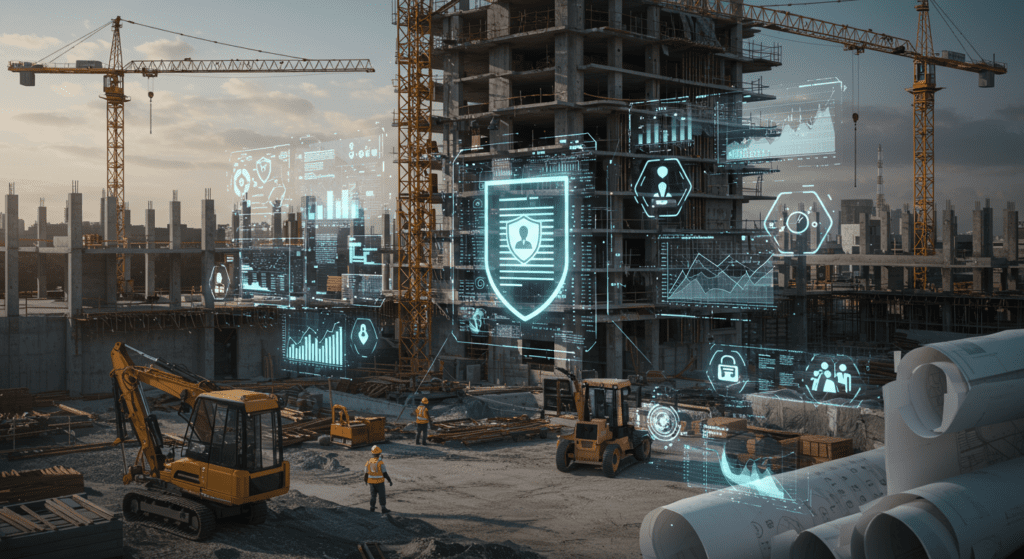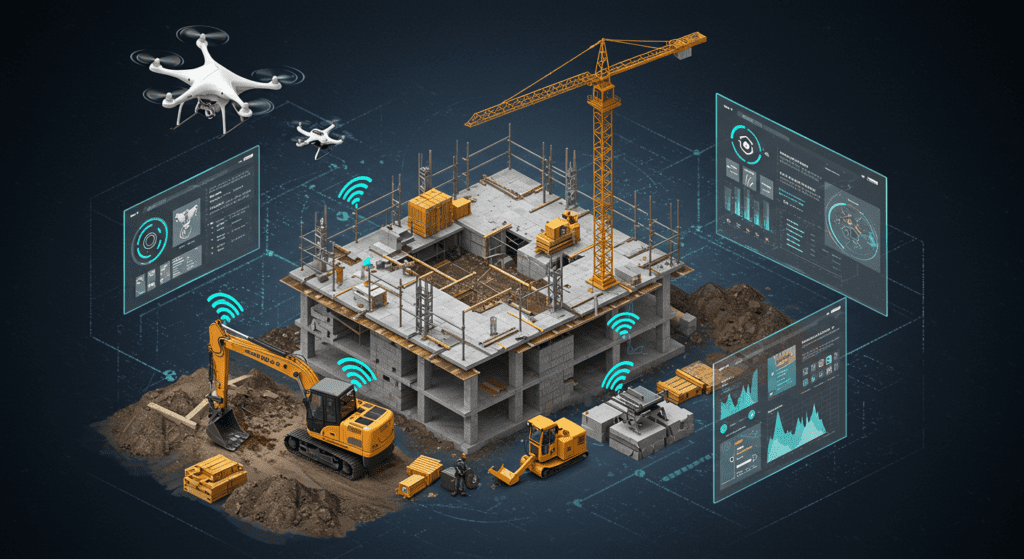- The Evolution of Construction Insurance
- Emerging Digital Tools in Risk Assessment
- Data Analytics and Predictive Modeling
- The Role of IoT on Construction Sites
- Automation and AI in Underwriting and Claims
- Cybersecurity Concerns in Construction Insurance
- Benefits of Smart Contracts and Blockchain
- Case-Studies: Technology Success Stories
- Future Trends and Industry Outlook
The integration of advanced technologies into construction insurance is disrupting long-standing practices and redefining risk management in the industry. From modern data analytics to blockchain solutions, technology is enabling insurers to enhance underwriting processes, streamline claims management, and improve overall risk assessment.

1. The Evolution of Construction Insurance
Traditional construction insurance relied heavily on paper-based documentation and manual risk assessments. Historical methods were not only time-consuming but also prone to human error. Over the past decade, the rapid pace of technological development has led to a paradigm shift in the way construction insurance is administered. Digital transformation has enabled industry players to collect and analyze vast amounts of data, offer dynamic pricing models, and enable real-time monitoring of construction sites. As a result, both insurers and construction companies now benefit from more accurate risk assessments and enhanced operational efficiency.
2. Emerging Digital Tools in Risk Assessment
Digital tools, such as advanced software programs and mobile applications, are now a vital part of the construction insurance landscape. These tools help adjust risk assessment models by incorporating on-site corrections and environmental factors into underwriting evaluations. Devices connected to the internet can monitor critical hazards and provide live feedback on the conditions prevailing at a construction site. Today’s risk assessment is more agile than ever before, able to integrate various data points in real time, leading to a significant improvement in risk management, streamlined communication, and quicker decision-making processes.
3. Data Analytics and Predictive Modeling
The explosion of data, combined with the capabilities of emerging analytical tools, is transforming underwriting and claims management processes. Data analytics allows insurers to build detailed profiles for construction projects by integrating historical incident rates, local weather patterns, and even economic trends. Predictive modeling techniques further enhance this process by forecasting potential risks before they occur. By mining large datasets, insurers can identify patterns and correlations that were previously overlooked. As a result, insurance coverage is becoming more personalized and better tailored to individual needs, minimizing losses and optimizing premiums.

4. The Role of IoT on Construction Sites
The Internet of Things (IoT) has had a substantial impact on construction safety and insurance risk assessment. Deploying IoT sensors throughout a construction site can provide real-time data on environmental and structural conditions, such as temperature fluctuations, moisture levels, and vibration patterns. This constant flow of information informs insurers on immediate risks and enables proactive measures to prevent accidents. Additionally, IoT applications in equipment tracking contribute to reducing theft and equipment failure, which in turn lowers the probability of major claims. The integration of IoT thus links safety and efficiency on the ground to reduced financial exposure for insurers.
5. Automation and AI in Underwriting and Claims
Artificial Intelligence (AI) and automation are at the forefront of reducing administrative burdens in construction insurance. AI-powered systems are now capable of processing claims more rapidly and accurately than ever before. By automating routine tasks such as data entry and initial risk evaluation, insurers can allocate more resources to solving complex issues and tailoring policies to suit client demands. AI algorithms are also in use to detect fraudulent claims by recognizing anomalies in submitted data, thereby ensuring that genuine claims are processed promptly while minimizing the risk of false claims. Automation in underwriting further speeds up the process, as computer algorithms can process vast arrays of data to determine the risk profile of a construction project in minutes instead of days.

6. Cybersecurity Concerns in Construction Insurance
As construction insurance becomes closely tied to digital platforms, cybersecurity emerges as a significant concern. The increasing use of connected devices and centralized databases makes the industry a target for cyberattacks. Data breaches can lead to the loss of sensitive information, disrupt operations, and erode trust between insurers and their clients. Enhancing cybersecurity measures is thus a top priority, with companies investing in advanced encryption techniques, multi-factor authentication, and continuous monitoring systems. Insurers are also collaborating with cybersecurity experts to develop frameworks that ensure the safety of both client data and operational functions. Addressing cybersecurity concerns is imperative for maintaining the integrity and reliability of digital construction insurance systems.
7. Benefits of Smart Contracts and Blockchain
Blockchain technology and smart contracts are rapidly gaining traction as tools to boost transparency and efficiency in construction insurance. Smart contracts are self-executing agreements written into code, with triggers that can automate payments or verify compliance throughout the project lifecycle. Blockchain allows for immutable, time-stamped records of all transactions, preventing disputes and fraudulent claims. The adoption of blockchain ensures that all stakeholders, from insurers to construction companies, have access to a secure and transparent ledger of information. These innovations not only reduce administrative costs but also provide a robust framework for managing complex contractual obligations, leading to smoother claim settlements and consistent policy enforcement.

8. Case Studies: Technology Success Stories
Several success stories highlight the tremendous impact of technological integration within the construction insurance sector. In one notable example, an insurer partnered with a technology firm to implement IoT sensors and a centralized data platform on large construction sites. This initiative enabled the real-time monitoring of site conditions and equipment, resulting in an impressive decrease in accident rates and claim occurrences. In another case, the adoption of AI in claims processing reduced settlement times by almost 40%, leading to increased client satisfaction. Additionally, the implementation of blockchain technology by a pioneering construction insurer helped minimize disputes over claim histories and improved trust across the board. These case studies demonstrate that technological advancements are not just theoretical; they are actively redefining risk management practices and creating tangible benefits.
9. Future Trends and Industry Outlook
The future of construction insurance is expected to be driven by further technological innovation. Advancements in sensor technology, coupled with the continued development of AI and machine learning algorithms, will deepen the scope of real-time risk analysis. Integrating augmented reality (AR) and virtual reality (VR) could also revolutionize safety training, enabling construction workers to experience simulated risk scenarios before they step onto a physical site. Moreover, greater collaboration between insurers, tech companies, and construction firms will pave the way for integrated platforms that streamline the entire insurance lifecycle—from policy issuance to loss mitigation and claims management.
The expanding role of digital twins—virtual replicas of physical construction projects—and advances in robotics are likely to improve operational insights and automate hazardous tasks on site. As these trends grow, the need for robust cybersecurity frameworks will intensify. This will push the development of industry standards and regulatory measures to protect both digital infrastructure and sensitive information.
Another exciting prospect is the emergence of on-demand insurance models powered by mobile applications and real-time data aggregation. This trend is likely to disrupt traditional insurance models by enabling instant policy adjustments based on evolving risk factors, thus aligning costs with actual exposure. In combination with smart contracts, these models promise a level of flexibility and responsiveness that was once unimaginable in the world of construction insurance.
The evolving landscape is also set to benefit smaller construction firms and subcontractors, who historically were underserved by traditional insurance models. Technological innovations provide the means to customize policies that accurately reflect the risks and exposures of projects of all sizes, enhancing overall market inclusivity. This inclusiveness not only spreads risk more evenly but also encourages safer practices across the industry through incentivized policies.

Conclusion
In summary, the construction insurance industry is in the midst of a significant transformation fueled by groundbreaking technological advancements. Real-time data, AI-powered analytics, IoT sensors, blockchain-based smart contracts, and enhanced cybersecurity measures are leading to more precise risk management and efficient claim processing. As these technologies evolve, they will redefine traditional underwriting practices, create more customized policy solutions, and ultimately lead to a safer and more resilient construction environment. The future holds immense promise, with a trend toward greater collaboration, enhanced technology integration, and new insurance models that focus on prevention as much as on remediation. The industry is poised for ongoing change, driven by the continuous pursuit of innovation that will benefit insurers, construction firms, and ultimately, society at large.
